This article concerns Titan combat walkers; for the Grey Knights' homeworld see Titan (moon).
"No Weapon in the arsenal of the Imperium or the Traitor equals the Titan on the battlefield, and a Legion of such vast war machines can bring any world to its knees. In truth, a Titan has only three enemies: folly, hubris, and another of its own kind."
- —Grand Master Volkus, Ordo Sinister of the Divisio Militaris
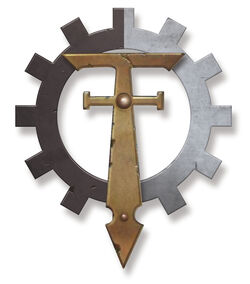
Symbol of the Collegia Titanica
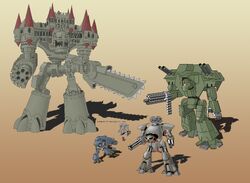
The Imperial Titan classes' relative sizes
A Titan is any one of several classes of massive, crewed, robotic bipedal combat walkers fielded by the Titan Legions of the Adeptus Mechanicus' Collegia Titanica or by the Forces of Chaos' Dark Mechanicum. Originally, this term referred to many types of combat walkers used by all of the different factions of the Milky Way Galaxy. Xenos Titans have now been renamed by Imperial savants with the same titles for these war engines as the species that created them, such as the Eldar Wraithlord or the Ork Gargants. The only robotic combat walkers considered to be "true" Titans at the present time are Imperial Titans and the Chaos Titans of the Dark Mechanicum. Titans are the most sacred war machines of the Adeptus Mechanicus and they are thought by the Cult Mechanicus to be the greatest physical embodiments of the Machine God. Titans represent the real backbone of the Mechanicus' military might and are the heaviest ground units that can be deployed by the Imperium of Man's armed forces. Every Forge World of the Adeptus Mechanicus is protected by armed forces that include the Skitarii, Praetorian Servitors, and one or more of the Titan Legions of the Collegia Titanica.
Titans are considered the largest and most powerful types of war engines available to the different factions of the galaxy and have primarily featured in the Epic 40,000 series of games, though the 2007 Warhammer 40,000 supplement Apocalypse now allows the smaller Battle Titans to be used in the game. War engines vary immensely in role and size, ranging from the massive Battle Titans to super-heavy tanks and large armoured personnel transports; the only things they share in common are a large size and high damage endurance. In the Winter Assault expansion to the computer game Warhammer 40,000: Dawn of War, an ancient, fallen Imperator-class Titan (the largest type of Battle Titan) can be seen. Its prone and half-buried wreckage stretches across an entire battlefield, and the barrel assembly of its right arm-cannon alone is over 30 metres in diameter.
God-Machines of the Mechanicus

A Warhound-class Titan towers over the battlefield

The "Pax Macharia" Imperator-class Titan
The first Titans were built during the Age of Strife on Mars, as a way for the newborn Cult of the Mechanicum (Adeptus Mechanicus) to effectively fight its enemies in the raging Martian civil wars on the Red Planet's irradiated surface. They were later sent with the Martian colonial fleets that established the first Forge Worlds, leading to the creation of the Titan Legions - armed forces made up entirely of Titans specific to that Forge World. Most Titans stand between 15 and 60 metres (about 50 to 180 feet) tall, though the extremely powerful and very rare Emperor Titans can stand up to 150 meters (400 feet) in height. There are a variety of different classes that a Titan can belong to, but all Titan Legions ultimately serve the division of the Adeptus Mechanicus called the Collegia Titanica. Most Titan classes belong to one of three separate physical types, Scout Titans, Battle Titans and the larger and more powerful Emperor Titans. Scout Titans include many smaller, more mobile classes of the great war engines which are used for reconaissance and infantry fire support missions by most Titan Legions. Battle Titans are the most commonly deployed form of Titan and provide the backbone of any Titan Legion's strength. The rare Emperor Titans are the true kings of the battlefield in the Warhammer 40,000 universe, and the two classes of these Titans are used to provide a Titan Legion's primary offensive and defensive power.
Due to their importance and high standing in the Imperium as a result of the advanced technology used in their creation, all Titans are important enough to be given their own High Gothic names when built. This is represented in published materials by giving each one a two-word Latin name, always some venerated title or concept, usually from the Imperial Cult. Examples include Aquila Ignis, Regalis Annihilatus, Vitas Falco, Imperius Eradicus, Imperius Belladon, Apocalyptus Credo, Imperius Brontos, Imperius Excelsior, Dies Irae, Octimus Ligus, Imperius Augusta and Imperius Dominatus. Similarly, the loss of a Titan is considered tragic and mourned by the Forge World that produced it.
Imperial Titans are unique in the sense that their computer mind-cores are sentient, albeit in a highly-erratic manner. This is in contrast with the usually non-sentient "machine spirits" or onboard computer systems found in many other Imperial war machines like tanks and armored vehicles. In the "Titan" comic, the newly connected Princeps was formally greeted by Imperius Dictatio inside its mental landscape; there was also Laudator Magnificat, which was forcibly reactivated after falling in combat. This proved disastrous: the mind-core had suffered severe psychological trauma from its "death", and began attacking everything in sight in its mindless rage.
Most Imperial Titans are roughly humanoid, but with thick lower legs, a hunched head, and an oversized torso. Forward-oriented main weapons mount directly into where the arms would be, and additional weapons are often found on the chassis. These configurations (called patterns) vary, and most Titans are built on these precepts. However the actual design of the chassis can vary greatly, so only the absolutely basic features (such as leg joints and weapon hardpoints) are constant. This is most evident in the Warhound class of Titans (the Lucius Pattern looks more geometric and broader than the Mars Pattern, the form of which is more rounded and animalistic).
Imperial Titan Classes
Warhound Scout Titans
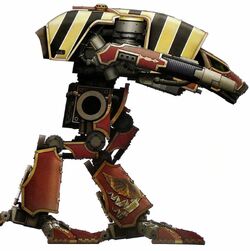
Warhound-class Scout Titan Advensis Secundus armed with a Plasma Blastgun and a Vulcan Mega Bolter, as deployed during the Taros Campaign
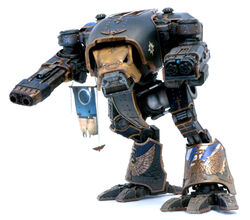
Imperial Warhound-class Scout Titan
Warhound-class Titans are the scouts or flanking elements of a Titan Legion and are the most common form of what are called Scout Titans by the Collegia Titanica. Appearance-wise, the Warhound differs structurally the most from other Imperial Titans; it possesses an anthropomorphized, canine-like shape, reverse-jointed legs and shoulder weapon mounts. Warhounds are lightly-armed and armoured compared to other Titans, although still fearsome compared to the more standard armoured combat vehicles deployed by the various intelligent races of the Milky Way Galaxy. They are the only Titans to be normally deployed by the Titan Legions in packs of two members, as compared to the larger Battle and Emperor Titans which usually operate alone. The Warhound Titans can only operate in a maximum of two as a result of the actions of Chaos Warhound Titans during the Horus Heresy. When the Traitor Titan Legions landed on Terra, Horus let them terrorize Terran civilians in squad-sized (10+) units of Warhounds. As a result of this blood-stained history, the Adeptus Terra during the Reformation of the Imperium after the Horus Heresy ordered the Titan Legions to never allow Warhound Titans to operate in squads large than two Titans to prevent such horrors from being perpetrated upon humanity again.
The Warhound is the first Imperial Titan that has received an official model kit from Forge World in the Warhammer 40,000 scale. Available in several patterns, classes and choice of weapons, they stand over 10 inches tall when assembled, and are 25 meters (75 feet) tall in "real life." The sourcebooks Imperial Armour and Apocalypse gives rules on the Warhound Titan, and have similar points for the Orks' Big Mek Stompa. On the battlefield, the Warhound has been proven to be very effective, with the new rules meaning that the double-barrelled Turbo Laser can destroy super-heavy enemies with ease.
Reaver Battle Titans
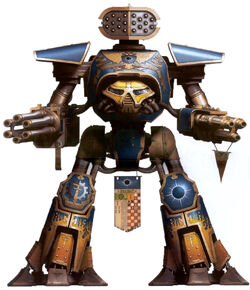
Mars Pattern Reaver-class Battle Titan Invigila Alpha of the Legio Astorum, the "Warp Runners"
A Mars Pattern Reaver-class Battle Titan of the Legio Gryphonicus, the "War Griffons"
The Reaver-class Titan is a medium-sized Titan and the smaller of the two known classes of Battle Titans. They are considerably more durable than Warhounds, and are able to take roughly twice the amount of damage of a Warhound. This extra durability is probably a result of the unusual placement of the plasma generator on the back of the main carapace, where in most Titans the generator is located in the core of the Titan, hence the term "energy core." This placement ensures that the Reaver Titan can take more frontal damage than other Titans of the same approximate class, but is at a severe disadvantage when in cluttered environments (cities or canyons). They stand just under twice the height of a Warhound - approximately 40 metres (121.92 feet). The Reaver is described as an older design of Titan than the Warlord.
The weapons mounted are variable; they can mount some of the more powerful Battle Titan weapons, although Scout Titan weapons are more common. Most of the patterns of the Reaver carry Multiple Rocket Launchers on their carapace mounting. Unlike Warhounds, Reaver-class Titans can use close-combat weapons, which are extremely effective in Titan-scale mêlée battles. However, it is suggested that Reavers are becoming increasingly rare in Imperial armies, and it is possible that the technological secrets to their manufacture have been lost to the Adeptus Mechanicus' Forge Worlds (a common fate for the more advanced Imperial technologies). For these reasons, Reaver-class Titans usually perform fire support, avoiding direct combat.
The Mars Pattern Reaver-class Titan's carapace mounts a Multiple Rocket Launcher and Turbo-Laser Destructors on each arm. The Lucius Pattern's carapace bears a Rocket Launcher, with the arms carrying a Volcano Cannon and Gatling Blaster. There is also a fire support variant of the Lucius, with Multiple Rocket Launchers on all three mounts.
The Reaver is the second Imperial Titan that has received an official model kit from Forge World in the normal Warhammer 40,000 scale. In the (now out-of-print) game Adeptus Titanicus, Reaver Titans were given names to distinguish their weapons load-out; these were the "Goth" (fire-support Titan), the "Vandal" (inspirational/morale-boosting Titan) and the "Hun" (a tactically flexible weapons loadout).
Warlord Battle Titans

Lucius Pattern Warlord-class Battle Titan
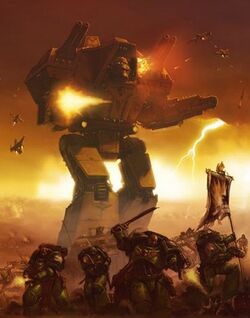
Lucius Pattern Warlord-class Battle Titan defends the forces of the Emperor
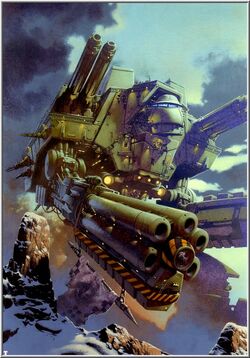
An Imperial Warlord-class Battle Titan in combat
Warlord-class Titans are a larger and more powerful type of Battle Titan than its counterpart, the smaller Reaver-class. They appear to be the most common class of Battle Titan in use by the Titan Legions, and many Forge Worlds field their own patterns. The Warlord is approximately 50% larger than the aging Reaver-class Titan, putting its height at around 60 meters (approximately 182.88 feet). The Warlord Titan is also able to withstand considerably more damage than the Reaver. The Warlord-class Titan has four Battle Titan weaponry hardpoints on the shoulders and arms, allowing for a greater variety of weapon configurations. While Scout Titan weapon batteries can be mounted, Warlords usually mount Battle Titan weaponry. There is even a specialist class based on the Warlord design, the rare Psi-Titans, where psychic weaponry is added for use against daemonic entities. Warlord-class Titans can also be organised into mixed Battle Groups with Reaver-class Titans (3 of each class of Titan). These Battle Groups can be armed and used as the group's commanding senior Princeps sees fit, but they work together to complete a common objective. In general, the Princeps of the more powerful or oldest Titan in a group is the commander of the Battle Group.
The Mars Pattern Warlord mounts two Turbo-Laser Destructors on its carapace, with a Volcano Cannon and Gatling Blaster on the arms. A special variant carries a close-combat Powerfist and Gatling Blaster on its arms, plus Vortex Missile and Rocket Launchers on the carapace.
The Warlord Titans were the first to be introduced in the Epic scale, featured as a box set with 6 plastic models and Styrofoam buildings. The accompanying rules were meant for Heresy-era Titan versus Titan combat. Simple rules for interactions with vehicles and infantry were subsequently published, and the Epic Space Marine box set developed the full initial rules for infantry and vehicles. In "The Siege of the Emperor's Palace" diorama for 2000's UK Games Day and since then on display in Warhammer World a Warlord Titan features on each side. Rules for normal Warhammer 40,000-scale Warlord-class Titans were introduced in the 2007 Warhammer 40,000 supplement, Apocalypse; however no model to represent it on the field has been produced by Games Workshop or its subsidiaries thus far, encouraging players to build their own from scratch should they wish to field such a weapon in their army. The expansion Apocalypse presented rules for the Warlord Titan. It can equip with all Warhound-class Titan weapons and has access to a variety of anti-infantry and destroyer weapons, including the Vortex Missile. However, it cannot engage close targets effectively. There is currently no model for the Warhammer 40,000 range, requiring scratch construction for the modeller. If one is to construct a Warlord, it should be approximately two feet tall to be of the proper scale alongside the other models. According to the out-of-print Adeptus Titanicus game, Warlord-class Titans are sometimes differentiated according to their weaponry. A Nightgaunt Warlord has two or more assault weapons, a Deathbringer Warlord has a 'tactical' (i.e. flexible) weapon fit, a Nemesis Warlord has two or more support weapons, while an Eclipse Warlord will have given some weapon hardpoints over to inspiring religious relics of the Imperial Cult such as the Devotional Bell.
Imperius Dictatio of the "Titan" graphic novels is a standard Lucius Pattern Warlord-class Titan.
Emperor Battle Titans
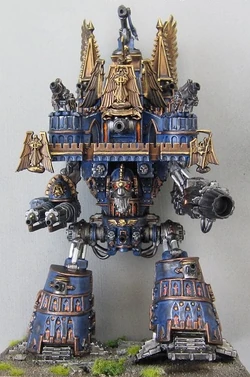
An Imperator-class Emperor Titan
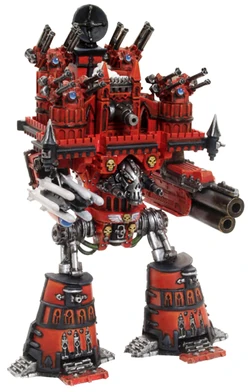
A Warmonger-class Emperor Titan
The superheavy Battle Titans called Emperor Titans are subdivided into two known classes, the Imperator-class Titan and Warmonger-class Titan. Of these, the Imperator-class Emperor Titan is a general-purpose assault platform, whereas the Warmonger-class Emperor Titan is a dedicated fire-support unit with advanced fire control and targeting systems. Both are extremely powerful weapon systems and are often unmatched by an enemy force on any battlefield where they are deployed. They are loaded to the brim with pre-installed weapons, and their mounts can handle Titan weapons too big for even Battle Titans (they do not carry any of the close-combat weapons, as their sole focus is on extreme firepower). Emperor Titans are very rare, and can crush many weaker war engines. This type of Titan has legs so large they can house a full company of Adeptus Mechanicus or Imperial Guard troops for defence and assault assistance. These Titans can stand up to 150 meters (approximately 400 feet) tall.
More than a war machine, these tremendous Titans are also icons of worship to the Imperial Cult Mechanicus, as they are seen as an avatar of the Omnissiah; the most noteworthy feature of an Emperor Titan is the fortified castle structure that occupies its entire upper half. These cathedrals possess ornate features like spired towers and stained glass windows. The "building" is heavily armed, and more than capable of contributing to combat. Due to the structure's prominent position on the Titan's back and shoulders, the Titan's head is hunched more than usual on the otherwise humanoid body, almost level with the arm weaponry.
In Winter Assault, the planet Lorn V houses the fallen Mars Pattern Imperator-class Emperor Titan Dominatus. The size of the Imperator-class Titan is driven home by the fact that in the last mission, most of the map is dominated by the half-buried fallen Titan, laying on its back, with exposed parts protruding through the earth like massive buildings. Once the Titan is partially repaired and powered up, even the guns studding its joints, labelled as "minor hull defense weapons" are able to destroy heavy vehicles in just a handful of shots. During the Dark Crusade, the planet Kronus was discovered to be home to the right arm and Hellstorm Cannon of the Imperator-class Emperor Titan Aquila Ignis, dismembered in a titanic battle during the Horus Heresy ten millennia prior. The Hellstorm Cannon was so large that its firepower carved a huge trench in front of where it lay. In the game, the fallen cannon's capacitors can be slowly charged by an entire array of powerful thermoplasma generator buildings. When fired, any units that are caught in the trench that mark its firing path are instantly destroyed. No unit in the game is durable enough to survive even a single blast.
Imperial Knights
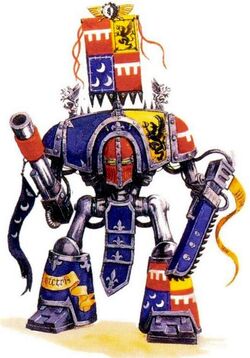
An Imperial Knight
Imperial Knights are combat walkers that are smaller and less advanced technologically than Titans, though they were built on the same principle, and were built by individual Imperial worlds as part of their Planetary Defence Forces (PDF). They can be seen as one-man mini-Titans. Unlike Imperial Titans, Knights use high-capacity energy cells rather than full-scale plasma reactors. Knights also benefit from power fields, which provide the same protection as Titans' void shields though they cannot be replenished in the course of a battle. Knights are the product of feudal agri-worlds within the Imperium and are, like the similar Sentinel walkers built on such planets, constructed in imitation of machines built by the Eldar - "Eldar Knights". While Sentinels herd sauropoda to be used as food sources, Knights defend them from predators. Three types were introduced in the 1990's - the Warden, Paladin and Lancer. The Wardens are defensive; armed with long-range heavy weapons and well protected with thick armour. The Paladin is fitted with a ranged weapon and a close combat weapon. The Lancer has only a single major ranged weapon but is faster and more mobile than the other types. The range was reworked in look and rules to "Paladin", "Errant" and "Lancer" types with the "Baron" as a superior command unit. A number of Knights were included in the Titan Legions box set (Epic 40,000 2nd Edition) and also feature as a hidden extra in the Final Liberation game.
Titan Armament
The weaponry carried by Titans is usually dedicated to certain tasks. Some are for targeting high-priority and well-armoured enemies, such as fortresses or armoured divisions, others are particularly effective against legions of troops and laying down devastating artillery barrages. Titan weapons are divided into two rough categories:
Scout Titan Weaponry
Scout Titan Weapons are weapons normally fitted to light Titans such as the Warhound. Rarely found on the largest Titans, and usually of short range, these are designed to destroy light to medium vehicles quickly, and to deal with huge masses of troops. Below are some examples of such weapons:
- Inferno Cannon- An upgraded version of the flamers mounted on vehicles, the triple-barrel Inferno Cannon is immensely devastating in close quarters against infantry and light vehicles, even those hiding in cover.
- Plasma Blastgun - The lightest plasma-based Titan weapon, and one of the most powerful that can be mounted on the Warhound Scout Titan. Although it possesses a relatively slow rate of fire, and is of only medium ranged, the Plasma Blastgun can badly damage well-armoured vehicles, Scout Titans, and devastate infantry squads by the means of having two different modes of operation, depending upon the nature of the target: a slower, more focused full-power blast, or more rapid but less powerful shots.
- Turbo Laser-Destructor - A Titan-scale laser weapon, mainly used for anti-tank/anti-Titan support. Very destructive compared to most vehicle and infantry-level laser weapons. More powerful than the Plasma Blastgun, as well as having a moderately longer-range, this weapon is well suited for sublimating small or heavily armored infantry units just as easily as it can pierce the thick, iron hides of all types of armored tanks. In game terms, it is also the only Destroyer weapon that a Scout Titan may carry. Although it can be fitted on a Scout Titan, the Turbo-Laser Destructor is more commonly found on the larger Battle Titans, who are much better prepared to deal with the constant threat of armored vehicles.
- Vulcan Mega Bolter - The Vulcan Mega Bolter is a Titan-scale Bolter weapon, comprised of two large-calibre Gatling gun-style assemblies. Projecting a withering volley of firepower, it is able to tear through infantry and light vehicles with ease.
Battle Titan Weaponry
Battle Titan weapons have more destructive and longer-ranged weapons mounted commonly on Reaver and Warlord Titans. Most are designed to destroy other Titans, engage enemy detachments, or bring devastation to fortifications.
- Close Combat Weapon - This encompasses an entire category of weapons that employ a Titan's prodigous strength and size to smash and tear apart the enemy. They are horrendously effective against enemy Titans and war engines - if the Titan can get close enough to use them. They can only be mounted on the Titan's arms; this rules out the Warhound. In Epic 40,000, close combat weapons include the Powerfist, Laser Burner and Chainfist.
- Gatling Blaster - The Gatling Blaster is a larger projectile weapon commonly found on Battle Titans. It is a rapid-fire weapon like the Vulcan Mega-Bolter, but instead fires 150 mm shells, powerful enough to inflict damage upon superheavily-armoured targets.
- Hellstorm Cannon - The Hellstorm Cannon is a huge, five-barrelled, directed-energy weapon that can completely decimate an entire city (perhaps even more) in just one cataclysmic salvo. In addition, the central structural hub around which the weapon barrels are mounted can itself be converted to mount a Gatling Blaster. A Hellstorm Cannon, detached from a long-destroyed Emperor Titan, can be seen lying on its side in near the city of Ironworks Bay (or Victory Bay, as it was later named by Lord-Militant Lukas Alexander) on the planet Kronus during the Dark Crusade. A trench large enough to move an armoured company through has been carved out of the earth in front of the cannon from its final firing.
- Melta Cannon - The Melta Cannon is an upsized Melta (fusion) Weapon mounted on Warlord Titans. Notably short-ranged, but incredibly effective at penetrating armour and destroying Titans.
- Multiple Rocket Launcher - The Multiple Rocket Launcher is a long-range artillery weapon which unleashes heavy barrages to suppress and devastate enemies. And because it is mounted on a Titan, it is much less vulnerable to air and fast attacks than dedicated artillery companies.
- Quake Cannon - The Quake Cannon is a very, very large artillery piece that is larger and more powerful than any other artillery weapon ever developed by the Imperium of Man.
- Volcano Cannon - The Volcano Cannon is powered directly from the Titan's plasma reactor, the Volcano Cannon has extreme range and is very effective at penetrating armour, making it useful primarily against war engines and other Titans. The Volcano Cannon is a favoured weapon of the Warlord and certain Reaver pattern Titans.
- Plasma Annihilator - The Plasma Annihilator is the largest and heaviest plasma weapon ever built by the Imperium. The Plasma Annihilator can demolish any fortification with ease, can destroy other Titans and can slaughter infantry in mass numbers because of its immense size and power. It takes enormous amounts of energy directly from the Titan's reactor and takes a long time to cool down.
- Missile Pod - Warlord Titans can carry a Missile Pod on one shoulder hard-point. While Warmonger and Imperator-class Emperor Titans can also carry them, this is rare.
- Apocalypse Missile Launcher - The Apocalypse Missile Launcher is the equivalent of the Multiple Rocket Launcher, however it is more commonly mounted on the carapace of a Warlord than the Multiple Missile Launcher.
- Vortex Missile Launcher - The Vortex Missile Launcher fires a missile that creates a Warp vortex (a controlled black hole leading to the Immaterium, an alternate dimension inimical to all matter), which destroys tanks and infantry instantly. The vortex that is created either collapses on itself, or it can also drift across the battlefield,causing massive damage to foes (and friends) even if the missile does not hit its target. Super-heavy vehicles and bio-constructs are too large to be sucked wholesale into Warp vortices, but still take massive damage instead. The same arcane technology is used in the man-portable vortex grenades.
- Titan Warp Missile Launcher - Titan Warp Missile Launchers fire missiles that ignore Void Shields before they strike their target by phasing into the Immaterium, which makes them very effective in Titan versus Titan engagements.
Specialised Titan Weaponry
Over the long centuries before the 41st Millennium, the Adeptus Mechanicus developed a large number of other weapons and add-ons for their Titans. Most of these weapons are only effective in a given situation or for a given task, hence they are seldom made part of a Titan's standard payload.
- Corvus Assault Pod - The Corvus Module or Corvus Assault Pod is in essence a boarding torpedo fitted to a Battle Titan's arm. When a building needs to be claimed relatively intact, the Titan will ram the tip of the Corvus Pod through the building's outer wall, creating an entry point for the Mechanicus Skitarii warriors transported inside.
- Deathstrike Cannon - The Deathstrike Cannon is a starship-grade Macrocannon fitted on a Warlord-class Battle Titan. A rarely-fielded conversion, it requires the whole head of the Warlord to be removed, and the cockpit to be installed on the top of the Titan's carapace instead. Despite the severe limitations this imposes on the Warlord, the Deathstrike Cannon's colossal range and power makes it a useful artillery weapon, able to obliterate fortifications or harass an enemy's rear lines and staging areas at extreme long range.
- Titan Chainfist - Similar in concept to the Chainfist wielded by Terminators, it takes the form of either a three-fingered claw with a large chainsaw attachement or a gigantic circular saw. Thanks to the available power from the Titan's massive plasma reactor, Titan-grade Chainfists are also equipped with a secondary Melta Array, to soften up the target while cutting through it.
- Carapace Landing Pad - Some Battle Titans transform one of their carapace weapon hardpoints into a small landing pad from which a small VTOL aircraft, similar to a Land Speeder, can operate. The small aircraft is directly linked to its parent Titan's Mind Impulse Unit, granting the Titan's Princeps an extra set of eyes and ears that can provide invaluable information without having to risk a Scout Titan to obtain it.
- Fire Control Center - A Fire Control Center is a battery of sensors, Vox-casters and MIU boosters fitted to a Titan's carapace hardpoint. It allows the Titan's Princeps to better coordinate fire between multiple Titans, and even other Imperial forces if required. Since most Titans are ferociously independent, this is a rarely used form of tech-arcana, and is only fielded when the whole of a Titan Legion must be deployed to obliterate a truly mighty opponent.
- Harpoon Missile - A Harpoon Missile is actually a jury-rigged weapon, cobbled together from a device that allows the Mechanicus to override a Titan's MIU in the case a Princeps fails at controlling it. The mechanism inside the Harpoon will override the rebellious Machine Spirit, forcing it to shut down or to obey the Harpoon operator's commands. During the Horus Heresy, this system was turned into a missile weapon in a desperate effort to bring rebellious Titans under control without having to destroy the priceless machines. However, the Harpoon Missile's efficiency was low at best, and the weapon became completely ineffective once the Titan had been altered by Chaos or possessed by a daemon. Today, this weapon is never fielded, and is only kept in reserve in case one of the Titan Legion's machines dominates its Princeps and runs amok.
- Turbo Battering Ram - A gigantic piston powered by electromagnetic coils, the Turbo Battering Ram is a siege weapon designed to hammer buildings and fortifications into rubble. Although it is much less efficient as a close quarters weapon than the standard Titan-grade melee weapons due to its ungainly bulk, it has the advantage of being able to trip or bowl over an enemy Titan with a well-placed blow, effectively taking the enemy God-Machine out of the fight without damaging it too much.
- Trident - The Trident is a device that originally served to bring rebellious Titans under control, but can prove extremely effective against an unsuspecting hostile Titan. It is a low-velocity barbed spear attached to a massive chain or cable that is in turn connected to one of the Titan's weapon hardpoints. It is thrown at a rebellious God-Machine's legs. Slow enough to ignore Void Shields, it will hammer deep into the leg, and the Titan who threw it will then move backwards and rotate at speed in the hope of tripping the rebellious machine, taking it out of a fight without damaging it irrevocably. Once prone on the ground, the rebellious Titan can be accessed and deactived with much less risk, for it will not be able to rise or bring its armament to bear.
- Wrecker - The Wrecker is a gargantuan wrecking ball attached to a Titan's arm hardpoint, and sheathed in a power field to ensure maximal destruction. As destructive as it is unsubtle, this massive siege weapon can turn the most strongly fortified building into rubble in a matter of moments. The Wrecker has never been favoured as a close quarters Titan weapon, for it is far too awkward and unbalancing to wield efficiently against a moving opponent, but should it connect, nothing can withstand its destructive impact.
Titan Defences

Imperial Titans face an Ork WAAAGH!
Imperial Titans become increasingly well-armoured as their size increases. They also have Void Shield generators to augment existing protection, which are able to absorb destructive energy on the Titan's behalf, although there is a limit to how much they can handle. They are directly controlled by the Titan's Princeps and can be left running after having absorbed dangerous amounts of energy to allow for extra protection. This, however, has a high chance of permanently damaging the generator.
Void Shields always come in sets to maximize the likelihood of at least one remaining up after a barrage, and larger Titans may have as many as six or more fields. They cannot, however, defend against everything. They cannot, for instance, block melee weapon strikes and special technology like the "Titan Warp Missile", which bypasses normal defences by travelling through the Immaterium. It is also theoretically possible for a truly massive amount of small-arms fire to eventually bring down a shield, giving infantry a remote chance of affecting a small Titan. For practical purposes, however, most infantry weapons would have little chance of damaging the Titan's armor even if no void shields protected it. Furthermore, a mere fraction of a Titan's return fire - or even a Titan's ability to physically crush attackers - makes this an ill-advised option for infantry, except in the most desperate of situations.
Emperor Titans are also commonly equipped with point-defence weapons to protect themselves against infantry and aircraft that cannot be effectively acquired by the targetting systems of their larger-scale weaponry. Carapace-mounted Multilasers are often employed in this respect, as are more exotic weapons for dealing with aircraft.
Titan Construction
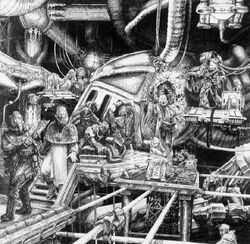
A Titan crew disembarks, as the Adeptus Mechanicus Tech-priests begin their work

A Warlord-class Battle Titan secured in its moorings aboard an Imperial Navy starship and readied for a planetary combat drop
Very little is known about the methods used in the construction of Imperial Titans. It is known that many Forge Worlds are capable of producing their own patterns of these massive war engines. Of these Forge Worlds, Mars and Lucius produce the most commonly employed patterns of the major Titan classes, and other large Forge Worlds such as Ryza and the recently destroyed Gryphonne IV do so as well.
Often times, the Imperium no longer has the skills required to build new items of advanced technology, as the knowledge of their construction has been lost over the millennia due to the general decay of Imperial society. Titans, however, were not built using STC templates from the Dark Age of Technology (with one exception), and as such the Adeptus Mechanicus has maintained the necessary knowledge of how to build the majority of Titan variants. As the process of building any machine by the Mechanicus currently requires the performance of complex ceremonial rituals, the construction of a Titan is an immense undertaking, and sometimes requires many Terran centuries to complete, drawing on the skills of experienced and talented fabricators and the purest of raw materials.
Standard Template Construct Titan
The completely autonomous and artificially intelligent Castigator-class Titan was the first and only of its kind ever built. Called the Father of Titans, it was first designed during the Dark Age of Technology and its design was stored in the Standard Template Construct database, but became forgotten as time passed. The Castigator made use of highly advanced, long-lost technologies such as rapid self-repair routines, and a synthetic muscle-like locomotive system. Standing larger than even the Imperator-class Emperor Titans, the Castigator notably had its head on top of its body, matched by an elegant yet super heavy and very well-armoured chassis and impossibly-graceful movement, and it was far superior to any class of Titan utilized by the Adeptus Mechanicus or any other intelligent race in the galaxy. Its weapons included an arm-mounted melee weapon and a super-heavy, multi-barrelled cannon that fired daemons. The ability to fire daemons was later found to be due to a pact the Castigator's Machine Spirit (A.I.) had formed with the Chaos Gods. The only known Castigator-class Titan was brought down by the Grey Knights who destroyed its reactor. The portion of the STC database containing the data for the manufacture of the Castigator was destroyed by the Mechanicus because the design had proven so susceptible to Chaotic corruption.
Titan Crew
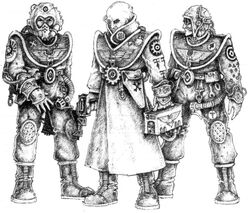
An Imperial Titan Crew; a Senior Princeps flanked by two Moderati
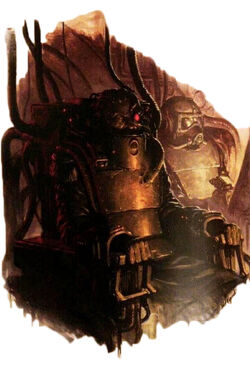
A High Princeps of the Legio Astorum on the command bridge of his Reaver-class Titan
The commander of a Titan is an individual who is a member of the Adeptus Mechanicus' Collegia Titanica called the Princeps, a rare individual in that he can retain his sanity after connecting with the "Machine Spirit" (computerized artificial intelligence) of the Titan through an MIU (Mind Impulse Unit) neural interface. The Princeps controls the Titan by means of the mental link provided by the MIU. Using this ancient technology, the Princeps merges his or her consciousness with the Titan's sentient "Machine Spirit" -- its artificial intelligence. The Mind Impulse Unit enables this link by creating an interactive and immersive sensory space -- sometimes referred to as "the Manifold" -- in which the Princeps can comprehend his war engine and his environment when he becomes the towering war engine. The Titan is operated, in enforced cooperation with the Machine Spirit, through mental commands issued in the Manifold by the Princeps. Such neural enmeshing is extremely taxing, and most Princeps cannot bear the strain of controlling all of a Titan's systems -- and those who do, only can for short periods of time. Thus the Princeps must be assisted in operating the war machine by junior officers called Moderati, whose purpose is to operate some of the Titan's systems in their commander's stead.
To establish the link between the Machine Spirit and the human mind requires that the Princeps submit to extensive cybernetic augmentation of his or her central nervous system, either by accepting the implantation of a several cybernetic implants at the back of the neck and skull, a series of implants in the spine which enable the linking of the MIU to the spinal cord or even undergoing entombment in an amniotic tank with large parts of the body rewired to accomodate cybernetic interaction with the Titan. Additionally, some Titan Legions utilise auxilliary haptic connectors, though others discard such measures as too delicate and too easily compromised to be placed in a war engine. Some Titan Princeps are interred within an amniotic tank, a device filled with a jelly-like polycarbon fluid in which the individual is suspended, and equipped with augmitters and Vox-casters which allow the person within to communicate with his surroundings. The device acts as a complete life support unit, handling all of the vital functions of the Princeps within. The fluid's function is to suspend the individual within the casket, greatly lessening the strain on his motive system, and to create a stable neurochemical environment. Most usually, it is also a carrier of nutrients and oxygen, and in such a case the human within is modified to breathe it through his or her lungs. Sometimes, however, the fluid does not fulfill this function, and in this case the life support unit will provide external blood oxygenation and removal of excess carbon dioxide, which is then once again supplied into the body and into the right atrium. To facilitate such change, the Princeps' heart will possess an artificially created foramen ovale -- a hole between the upper chambers of the heart, allowing the blood flowing into the right atrium to bypass the lungs -- which perform no function while in the tank -- and enter the left atrium, from where it flows into the left ventricle and is further distributed across the body. Such an artificial circulatory system, as well as the body's suspension in amniotic fluids, closely resembles that of a gestating foetus within its mother's womb.
Due to their near-complete uselessness, the hands and feet of a Princeps interred in an amniotic tank are sometimes amputated and replaced with augmetic haptic sheaths that serve as a part of the broader Mind Impulse Unit. In addition, the eyes are occasionally removed, and the sense of sight, along with others, is replaced by the sensors and Auspexes of the Titan and those built into the amniotic casket. Eye sockets then serve as another medium of connection for the individual to the Mind Impulse Unit, possibly making use of the conveniently placed ocular nerves. The cybernetic link created via an amniotic interface is much deeper than that attained using hard-plugs, which makes disconnection from the MIU much harder. It is a complex ritual that can only be performed by a senior Tech-priest, and if not carried out appropriately the Princeps in question can suffer severe mental and neural trauma.
Internment in an amniotic tank allows the Princeps within to enmesh with the Titan's Machine Spirit more completely than he would ever be able to utilising only hard-plug connection. This greater and even more immersive connection grants an advantage in comprehension of the war engine and speed of reaction over a Princeps using the more traditional connection methods. A Princeps utilising amniotic interfacing is also at all times in remote communion with his war engine, even when the Mind Impulse Unit is deactivated and the Titan itself is shut down. Because of this permanent neural connection, these Princeps suffer none of the symptoms of withdrawal or the pain of separation which are the domain of pilots using standard hard-plug connection. However, due to this constant mindlink, and because of the atrophied state of their bodies, they are more exposed to the Mind Impulse Unit's effects on the psyche. This is only natural, for as the body atrophies and grows weaker from lack of use, the mind further withdraws into the depths of the Manifold and the personality is degraded. The human within slowly but surely is detached from his humanity, and eventually becomes nothing more than a dysfunctional part of the machine, his consciousness lost in the artificial mental landscape created by the Mind Impulse Unit.
For this reason, many Princeps hesitate to embrace amniotic immersion despite its advantages and fear the consequences it would bring, while some other members of a Titan's crew view such individuals with a measure of unease and uncertainty. Still, amniotic interfacing offers considerable advantages, and for this reason its use is standard practice in some Titan Legions, and some patterns of Titans require it by design. Princeps will also be modified for internment in an amniotic tank in order to save their lives, for example after they sustain great physical or mental trauma, as often occurs after surviving the destruction of a Titan, or when their addiction to the link grows severe enough that they may not be able to bear disconnection from the MIU. Amniotic immersion is then used to preserve their ruined bodies and to keep their sanity intact through the permanent connection to the Mind Impulse Unit it allows.
When the Princeps is linked to a Titan's MIU, he feels the Titan's body as if it was his own -- his hands become weapon arms, his senses are turned into powerful Auspexes and his skin becomes the thick adamantium hull -- an experience of supremacy and escape from human frailty that addicts every Princeps to his or her link with a Titan. The Princeps is then able to command the Titan intuitively -- he merely needs to think of undertaking an action and the machine complies. During this operation, the Princeps does not lose conciousness of his own body, and is able to simultaneously move and act as normal within the Titan's cockpit. It requires a strong will to maintain this connection, and Titans can go out of control on rampages of destruction should the Princeps fail to maintain dominance over its sentience. Particularly ancient and war-worn Titans are known to hold neural imprints of all their previous Princeps' personalities in their machine spirit. There has also been noted rare instances where a Princeps has died while connected to the Titan, thus creating a digital "ghost" of themselves that remains inside the Titan's Machine Spirit. This is often referred to as a "ghost in the link".
The process of linking the human mind to a God-Machine is very difficult and dangerous, as a Titan is possessed of a ferociously potent Machine Spirit; one that is unlike any other, harbouring its own savage and instinctive intelligence. The Princeps must break the machine's opposition and bind it to his will -- a feat requiring enormous willpower. Because of this, Princeps are rare individuals, and one of the tasks the Collegia Titanica carries out is to discover them wherever they can be found and train them to command the colossal war engines. Whilst normally the Adeptus Mechanicus searches for its personnel within the Cult Mechanicus, the sheer rarity of such individuals requires the Mechanicus to search in the broader populace of the Imperium. Barely one in ten million possess the necessary qualifications to serve as a Princeps, and even fewer of this number make it through the training to finally command a war engine. Because of this reality, Princeps are immensely valuable individuals, and their home Forge World will spare no effort to recover them should they go missing in action, and if the slimmest chance exists that they are still alive. There are two ways in which one can become a Princeps -- undergoing training in Collegia Titanica academies, as mentioned above, or advancing from the rank of a Moderatus to a full Princepture, which is usually the command of Warhound-class Scout Titan.
There is also a perverse effect to the mind-link: it is highly addictive to the human mind. From the moment he manages to dominate his Titan's Machine Spirit, the Princeps will actively crave being linked to his war engine, for the feeling of becoming a godlike machine of destruction is impossibly intense, and living as a mere human eventually becomes intolerable for some Princeps. Alas, this withdrawal also accelerates the Princeps' descent into madness, straining his mind when he is not linked to his mighty war machine. If a Princeps does not fall in battle, he will ultimately fall to the Machine Spirit of his Titan when his will finally snaps.
Being linked to the Titan's Mind Impulse Unit is a considerable effort in itself, and controlling the war machine's systems precisely is difficult. Most Princeps are incapable of controlling all of a Titan's functions simultaneously due to the sheer, unbearable mental tumult it inflicts, and those who do will only do so for short periods of time. For this reason, Princeps are assisted in operating these towering war machines by junior officers called Moderati -- whose role is to operate some of the Titan's systems in their commander's stead -- lessening the mental strain placed on the Princeps and allowing for the efficient handling of the machine.
The mind-link is a very intimate and immersive connection, causing the Princeps and the Titan to leave an imprint in each other's consciousness and grow increasingly alike over time. The Titan's Machine Spirit will learn from its Princeps and from the battles they take part in, storing the knowledge and making it available at all times and to any Princeps that will command the war machine in the future. The Princeps on the other hand, will, with time, begin to show traits of character akin to those of his or her war engine. The nature of the Machine Spirits varies between individual Titans, however war engines of the same class will be similar. Thus, the commanders of Warhound-class Scout Titans are known to be bellicose and belligerent, and sometimes loners, though the latter may be due to their generally solitary assignments as scouts, while the Princeps of other war engines are more cool-headed and better capable of cooperation as part of a larger force.
The Princeps is seated on a command throne in the Titan's head, along with several system controllers and second-line bridge officers called Moderati who act as the Titan's command crew. Lower ranking officers called Steersmen often control the Titan's most basic functions like locomotion. The number of Moderati and Steersmen depends on the size of the Titan, and their duties involve secondary tasks like regulating and maintaining the massive walker's weapons and other systems, as well as monitoring and interpreting readings from the Titan's auspexes (complex arrays of various types of sensors). All Titan officers who are expected to serve as Princeps begin their career at the Collegiate Titanica on Mars where they are trained in how to pilot and interact with a Titan as well as many of the doctrines and rituals of the Cult Mechanicus.
Other Titan crew members include various engineers (usually Adeptus Mechanicus Tech-priests) for repair work and the necessary blessings required by the Cult Mechanicus, and Servitors who are set on the more mundane tasks required by the Titan like the manipulation of controls and the monitoring of the external Auspex systems. Some of the largest Titans also have Adeptus Mechanicus armed forces like Skitarii or Praetorian Servitors on board in case an enemy attempts to board and take control of or destroy the Titan.

Traitor Princeps merged with his war machine
Chaos Princeps
During the Horus Heresy, half of the Titan Legions declared support for the Warmaster Horus, and since those ancient times, the fickle blessings of the Ruinous Powers have warped many of them. Although some of the Traitor Princeps have remained largely unchanged, and are presumed to operate their machines as described above, the rest have become hideously disfigured and physically merged with the corrupted war machines they command, linking with them not only in mind, but in flesh as well.
Chaos Titans
During the Horus Heresy, half of the Adeptus Mechanicus, including several hundred Titan Legions, turned to the worship of Chaos, taking their mighty war machines with them. Chaos Titans are usually similar to their Imperial counterparts, but their long exposure to the warping influence of Chaos has changed many of them. In some cases, the crew has merged with their machine, making it impossible to tell where one ends and the other begins. Other crews have given themselves and their weapons over solely to one of the four great Ruinous Powers of Chaos.
The most infamous of these monster war machines was the Imperator-class Emperor Titan Dies Irae (literally "Day of Wrath" in High Gothic) which stormed the battlements of the Imperial Palace during the Battle of Terra. It was eventually destroyed 10,000 years later, during an Iron Warriors campaign against the Imperial world of Hydra Cordatus, where the Dies Irae engaged in battle with an entire demi-legion of twelve Imperial Titans, destroying almost all of them before finally being stopped by the Warlord-class Titan Honoris Causa. Dies Irae is featured in the first five books of the Horus Heresy series.
Feral Titan
Feral-class Titans are twisted versions of the Imperial Warhound-class Titan and are used for the same tactical purposes by the Forces of Chaos. To their eternal shame, the Titan Legions bear the stain of disloyalty to the Emperor like so many other branches of the Imperial armed forces. Like the Legiones Astartes, many of the Titan Legions also sided with Horus against the Emperor during the dark days of the Horus Heresy, and eventually fled to the dark refuge known as the Eye of Terror when their master was defeated. Within the Forces of Chaos, the dreaded Chaotic Warhound-class Titans, reclassified as Feral-class Titans by the Imperium, have seen millennia of service in the Traitor Titan Legions' pursuit of the Long War against the Imperium of Man, becoming utterly corrupted by the daemonic powers of the Warp and the fickle favour granted to these vile war machines by the Ruinous Powers. Many of these dreaded war machines easily date back to long before the Horus Heresy and have had their Machine Spirits wholly corrupted and possessed by the Warp-touched powers of Chaos. The Titan's Machine Spirit and its damned crew become possessed by daemons and are doomed to serve the will of the Chaos Gods in battle for all eternity.
Ravager Titan
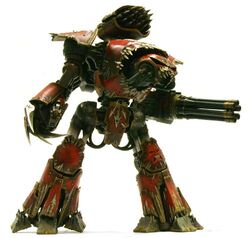
Chaos Reaver-class Battle Titan, also known as the Ravager-class after its corruption by Chaos
Ravager-class Titans are the Chaos versions of the Imperial Reaver-class Titan. Within the Forces of Chaos, the Reaver-class Titans are ancient and irreplaceable relics left over from the days of the Horus Heresy. To differentiate these corrupted Reavers from their Imperial counterparts, the Imperium has redesignated these war engines Ravager-class Titans, though this name is rarely used. They are the remnants of those Traitor Titan Legions who sided with the renegade Warmaster Horus during those dark times and whose blasphemous names still echo with dread thousands of Terran years later. The majority of these monstrous war engines have seen millennia of service with the Chaos forces and have long since become utterly corrupted by the touch of the Ruinous Powers and the Warp. Others are salvaged Imperial war engines taken from the battlefield as spoils of war, much to the eternal shame of their former masters. These captured Battle Titans have been subjected to bloody rituals in order to consecrate them to the service of the Chaos Gods. Over time, Chaos Reaver Battle Titans become an amalgam of daemon and machine, their once living crews fused to the controls and their souls subsumed into the Titan's tainted Machine Spirit, the war machine itself now a single being dedicated to destruction and butchery, reborn to spend an eternity of battle in servitude to Chaos. Revered and tended to by the Warp-tainted Hereteks of the Dark Mechanicus, lesser servants of the damned view these towering engines of destruction as incarnate gods of fire and death. Many of the lesser beings who serve Chaos make obeisance to them, offering sacrifices of captives and even their own lives to slake these towering monsters' thirst for blood.
Chaos Warlord Titans
Amongst the Forces of Chaos, Warlord-class Chaos Titans are ancient and irreplaceable relics left over from the days of the Horus Heresy. They are the remnants of those Traitor Titan Legions who sided with the Renegade Warmaster Horus during those dark times and whose blasphemous names still echo with dread thousands of Terran years later. The majority of these monstrous war engines have seen millennia of service with Chaotic foces and have long since become utterly corrupted by the touch of the Ruinous Powers and the Warp. To differentiate these corrupted Warlords from their Imperial counterparts, the Imperium has designated these war machines with different class names that have been happily adopted by these Titans' Renegade crews. The Chaos Warlord-class Titan has 4 different variants depending on which Ruinous Power of Chaos the Titan is aligned with. Even though there are different versions of the Chaos-altered Warlord-class Titan, the most commonly seen variant operating with the Forces of Chaos is the Banelord Titan.
- The Banelord-class Titan is dedicated to the Chaos God Khorne and has been modified with a long tail that ends in a large cannon of various types, while another such cannon protrudes from the Titan's daemonic mouth. The Banelord also has access to three special weapons: a Havoc Missile Rack, a Hellstrike Cannon and a Doomfist. This is the most common Chaos Warlord Titan.
- The Plaguelord-class Titan is dedicated to the Chaos God Nurgle.
- The Painlord-class Titan is dedicated to the Chaos God Slaanesh.
- The Warplord-class Titan is dedicated to the Chaos God Tzeentch.
Chaos Emperor Titans
Imperator-class and Warmonger-class Emperor Titans are the greatest war engines ever created by the Imperium of Man. Those few Emperor-grade Battle Titans to fall into the hands of the Traitor Legions during the Horus Heresy that still exist today are rarely deployed on the battlefield and only when the Forces of Chaos have decided that they are willing to pay any cost to secure a victory. Most Chaos Emperor Titans have been possessed by Greater Daemons which have transformed these great war engines into towering leviathans of Warp-corrupted steel and Adamantium, a true incarnation of the power of Chaos in the material realm.
Notable Chaos Titans
- Abominatus - Abominatus, the Despoiler of Worlds, was a special class of Chaos Imperator-class Titan that was fused with a Greater Daemon of Khorne.
- Augmenautus Rex - The Chaos Imperator-class Titan Augmenautus Rex fought against the Legio Invicta and the Legio Tempestus forces defending the Forge World of Orestes in 779.M41. It vaporised the Legio Tempestus Warlord-class Titan Orestes Magnificat with a single shot. The Princeps of the Legio Invicta Warlord-class Titan Sicarian Faero, Vancent Kung, linked his MIU (Mind Impulse Unit) with those of Titans from three battlegroups to take down the Augmenautus Rex with an assault coordinated by a single mind. Such a measure, although forbidden, was required as the Imperator-class Titan's Void Shields were so potent that they would have withstood a more dispersed assault. It is said that after the Augmenautus Rex had fallen disabled, it took another ten minutes of sustained fire to destroy it.
- Bubonis - Bubonis, the Daemonic Plague Titan of Nurgle, was a special class of Chaos Imperator-class Titan that was fused with a Greater Daemon of Nurgle.
- Caligula - The Caligula is a Chaos Imperator-class Emperor Titan that is similarly aligned with the Blood God Khorne and host to one of his Greater Daemons.
- Dies Irae - The most infamous of these monster war machines was the Imperator-class Emperor Titan Dies Irae (literally "Day of Wrath" in High Gothic) which stormed the battlements of the Imperial Palace during the Battle of Terra and had been assigned to to the 63rd Expeditionary Fleet, the Warmaster Horus' own fleet, throughout the Great Crusade. It was eventually destroyed 10,000 standard years later in the 41st Millennium, during an Iron Warriors campaign against the Imperial world of Hydra Cordatus, where the Dies Irae engaged in battle with an entire demi-legion of twelve Imperial Titans, destroying almost all of them before finally being stopped by the Warlord-class Titan Honoris Causa.
- Skylok - Skylok, the Winged Titan of Tzeentch, was a unique Chaos Imperator-class Titan, which was created through its fusion with a Greater Daemon of Tzeentch.
Ork Gargants

The Ork equivalent of a Titan is called a Gargant. Gargants are as much idols of the savage Ork Gods, Gork and Mork, as they are engines of destruction. Big Mek Orks receive a divine vision of sorts from Gork (or possibly Mork), and set out to bring that vision to life in the artistic medium of thick armour plates, smoke-belching engines, and lots and lots of very large guns. This quickly spreads amongst other Big Meks in the area, and soon Gargants spring up all over the place. The construction of Gargants is one of the typical signs of an impending WAAAGH! from an Ork-held system.
In an Ork warband, there can exist Gargants and Gargant-like mecha war machines all the way from one-Gretchin (small, greenskinned goblinoid creatures closely related to Orks) Killa Kans which are the Ork equivalent of the Space Marine Dreadnoughts to the vast armoured behemoths of the Mega-Gargants. From smallest to largest, the most typical machines of these type include:
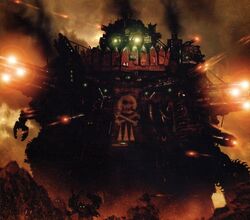
Stompas
Stompas are neither war engines nor Titans proper but rather large, armoured fighting vehicles built as roughly Ork-shaped effigies. They are armed with both long- and short-range weaponry and are used in the same manner as heavy tanks. Supa-Stompas are significantly more powerful than regular Stompas, and count as war engines. They can mount two of the weapons that are carried on the larger Gargants and can be seen as equivalent in firepower to a Warhound-class Scout Titan of the Imperium.
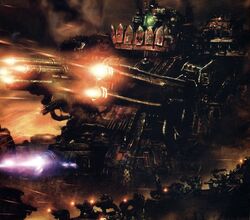
Gargants
Gargants and Great Gargants are the archetypal Ork Titans. They are massive constructions broad and squat compared to an Imperial Titan. They are fitted with many batteries of guns and also tend to have at least one mega-weapon. They are roughly equivalent to Reaver and Warlord Titans, respectively.
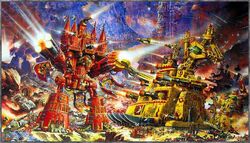
Imperator-class Titan faces off against an Ork Mega-Gargant
Mega-Gargant
The Mega-Gargant is a very rare, super-large Gargant on a par in size with the Imperator and Warmonger-class Emperor Titans, though not as powerful. It carries a large number and variety of weapons including the Mega-Dropper. Unlike the other Gargants which shuffle forward on their short mechanical legs, the Mega-Gargant is actually a tracked vehicle; essentially it is a mobile Ork fortress.
Big Mek Stompas/Gargants
Often a Big Mek Ork will not be satisfied with the production of Battlewagons, and will create his own Stompa or Gargant. These Titan-like monstrosities mount the latest Mek weaponry, such as the 'Lifta-droppa'. The size of the Stompa or Gargant depends on how much influence the Mek has, how much raw materials there are, and who they are 'constructing' it with. Occasionally, two Meks may work together, combining their love of tinkering to produce a new Gargant on their own initiative or because they have been commanded to do so by a larger, tougher Ork Warboss or Warlord.
Construction
Ork Gargants are an extremely varied lot, with no two ever being exactly alike, as is common with seemingly slapdash Ork technology. Thanks to the frenzied imaginations of the Mekboyz building them, Ork weapons tend to be haphazard, unreliable and noisy. When they work, however, they can inflict gruesome damage. Gargants are commonly equipped with at least one close-combat weapon, because charging in and bashing heads is considered to be a very "Orky" thing to do.
For defence, Gargants have Power Fields which are the Ork equivalent of an Imperial Titan's Void Shields; however, while Gargants tend to have more intense and reflective Power Fields that an Imperial Titan, they cannot regenerate these during the battle like a Titan is able to do.
Orks do not rely on auto-systems to the same extent as the other intelligent races, and Gargants carry a large crew of both Orks and Gretchins. The crew is led by a Kaptin, who relays orders through a body of officers. A speaking-tube is the preferred method of communication within a Gargant. Each officer is in charge of one section of the Gargant, be it a weapon, the magazine, the engine room, or any other chambers. Under the officer is a crew of Orks and Gretchins who carry out the orders passed down to them. Repair crews are composed of Gretchins, whose smaller build suits them for crawling through cramped spaces armed with wrenches and oily rags.
Compared to Imperial Titans, Ork Gargants have weaker armour and comparatively shorter-ranged weaponry. Nevertheless, Gargants are extremely difficult to destroy due to their dense (albeit crude) construction (in games, this is represented by Gargants having more structure points). While Gargants do not suffer from potentially fatal plasma reactor meltdowns, they are particularly vulnerable to fires and magazine explosions.
Eldar Titans
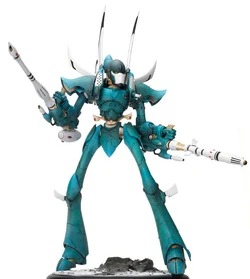
An Eldar Phantom Titan looming over the battlefield
Eldar Titans are quick and nimble machines of war. They are thinly armoured but despite their frailty, Eldar Titans can pack a mean offensive punch, and can move about the battlefield with frightening speed, thanks to their Jump Jets.
Instead of the Void Shields used by other intelligent races' Titans, the Eldar rely upon advanced holographic field generators which in conjunction with speed make their Titans extremely difficult to target. However, holo-fields do not actually deflect enemy firepower, so Eldar Titans are even more vulnerable should they suffer hits. Eldar Titans are also unlike those of other races in that they are powered by the actual spirits of individual Eldar contained in a core of psycho-reactive material called Wraithbone, which is a material also used in the construction of the Titan's carapace due to its light weight and great durability. The pilots of the machines link psychically with the Eldar spirits in their core, rather like the Princeps of an Imperial Titan linking to its Artificial Intelligence Machine Spirit; and this allows the Eldar pilot to control the Titan like an extension of his own body. The Eldar spirits, however, enhance the skills of the pilot as well as the Eldar's already superhuman reflexes and reaction times.
There are three types of Eldar Titans:
- The Revenant is a relatively light war machine, roughly equivalent to an Imperial Warhound, though much more agile. They are best suited for lightning-fast raids on enemy lines, using their speed to retreat before a counter-offensive can be mounted. A model of this Titan has been created by Forge World. It can come armed with either Pulsars or Sonic Lances. Like Imperial Warhound Titans, Eldar Revenant Titans are often deployed in pairs. The pilots of these pairs are usually siblings, their blood ties psychically linking them together for thought-speed communication during combat.
- The Phantom is a more massive Eldar war machine capable of taking on its Imperial equivalents. What makes Phantom Titans distinctive from those of lesser races is their crew. In addition to the living, the souls and memories of ancient Eldar warriors are maintained in the wraithbone matrix of the Titan.
- The Warlock is a refinement of the Phantom. Its wraithbone core hosts the spirits of late Seers and Warlocks, focusing their psychic power into a near-unstoppable engine of destruction.
Tyranid Bio-Titans
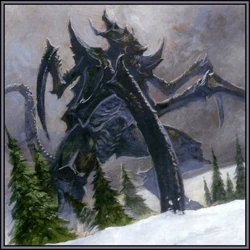
A Tyranid Bio-Titan leads the attack in an irresistible onslaught
Bio-Titans are more than exceptionally large Tyranid bioforms, they are on a par with the Titans deployed by the other intelligent races and were created by the Tyranid Hive Fleets to directly compete with the similar massive war engines they encountered amongst the other races of the Milky Way Galaxy. Bio-Titans are deployed in the final stages of the assimilation of a planet into a Tyranid Hive Fleet's biomass.
While their supersized biomechanical weaponry is potent, Bio-Titans are feared mainly for their extreme effectiveness in close combat against enemy Titans and other war engines. They are also considerably faster than Titans of other races; as a result Bio-Titans often charge towards the enemy. Their ripper tentacles can neutralize enemy Titan close combat weapons, while monstrous claws will make short work of Titan hulls.
Bio-Titans do not generate void shields like those of the Imperial Titans or Ork Gargants; however they made up for this by being able to "regenerate" or self-heal. Bio-Titans can generate bio-plasma fields to make them less vulnerable to sniping from Imperial Volcano Cannons, though this ability was present in early Bio-Titans produced by the Tyranids but newer iterations of Bio-Titans recently encountered by Imperial forces do not seem to possess this ability.
Examples of Tyranid Bio-Titans include the Vituperator, the terrifying Hierophant and the even more monstrous Hydraphant. They are roughly equivalent to the Imperial Warhound, Reaver, and Warlord Titans, respectively.
Regular Tyranid bioforms (not war engines, let alone Titans) include the tank-sized burrowing Trygon and the winged Harridan (a Tyranid war engine that is not considered a Titan). The Hierodule was used as the name of the smaller Bio-Titan (the Hierophant was the larger Titan) when the model range was released in November 1997, however the Hierodule is now just another bioform construction.
A specialist breed of Bio-Titan is the Dominatrix, a powerful synapse creature that can use its malign intellect to command the hordes of lesser bioforms around itself with ghastly efficiency. In the hierarchy of Tyranids, they are the supreme commanders of the battlefield and second only to the shipbound Tyranid Norn-Queens themselves.
Sources
- Adeptus Titanicus (1st Edition)
- Adeptus Titanicus (2nd Edition)
- Citadel Journal 13, "Abominatus, Despoiler of Worlds Chaos Titan", pp. 41-44
- Citadel Journal 10, "Skylok, Winged Titan of Tzeentch", pp. 31-37
- Citadel Journal 9, "Legions of Chaos: Bubonis, Daemonic Plague Titan of Nurgle" by James Funnell, pp. 4-11
- Citadel Miniatures Catalogue, Section Four, "Chaos Titan" by Dave Andrews
- Codex: Eye of Terror, pg. 16
- Codex: Tau Empire (4th Edition)
- Codex: Titanicus (1st Edition)
- Dark Heresy: The Black Sepulchre (RPG) pg. 45
- Imperial Armour Apocalypse 2, pg. 79
- Titan Legions: Rulebook (1st Edition) pg. 40-50
- Titan Legions (2nd Edition), pp. 11-16
- Warhammer 40,000: Apocalypse (4th Edition)
- Warhammer 40,000: Rulebook (5th Edition), pg. 121
- White Dwarf 194 (US), "Modelling Workshop: Abominatus, Despoiler of Worlds", pp. 39-43
- White Dwarf 108 (UK)
- Mechanicum (Novel) by Graham McNeill
- Dark Adeptus (Novel) by Ben Counter
- Titanicus (Novel), by Dan Abnett
